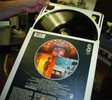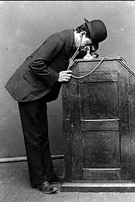|
The Evolutionary Journey of Motion Picture Media
with "Cinema Bob" Stilson
The burned-out bulbs, the worn-out reel pulleys, the jammed film ribbon melting at the lamp window –
those were the good old days of the celluloid movie experience! Many motion picture enthusiasts still long for the noisy,
mechanistic workings of those old 8 & 16mm movie projectors. As the saying goes, “they just don’t make things like they used to.”
We’ll start from those nostalgic days, move into the present, and even speculate at the future.
I’m delighted that my favorite movie critic and expert, “Cinema” Bob Stilson, has agreed to help us on this journey.
| |
All motion picture media systems rely on a physiological phenomenon called Persistence of Vision,
in which the combined human eye and brain retain an image long enough for the next frame image to be displayed.
The result is the viewer's perception of continuous motion.
Primitive by today's standards, Thomas Edison's
Kinetoscope was a technological
wonder in the 1890's.
The electric lamp and the invention of the
movie projector allowed large groups of people to enjoy the same
show together. This inspired more dramatic moviemaking and the
creation of the Hollywood industry.
In 1975 Sony released the Betamax videotape,
followed by the VHS format by JVC in 1976. These were magnetic
cassette tapes that recorded and played video signals using a
system called
helical scanning, where a tilted rotating drum would record
and read individual image frames in diagonal magnetic stripes
along the tape. This not only gave consumers the ability to
record TV shows for later viewing, but made movie rentals
practical and convenient.
|

Laserdisk (left) -
DVD (right) |
MCA and Pioneer put the Laserdisk on the
market in 1978. These were much larger than current DVDs
(see left) and not quite as reliable. They stayed in the
market until about 1982 when they could no longer compete
with videotapes for consumer interest.
|

Movie on a CED
disk |
In 1981 RCA began producing CED (Capacitance Electronic Disc)
disks for movie watching. These delivered good quality, but
damaged easily and could not properly fit long movies.
Today's common DVD (digital video disk) went
commercial in 1995. Better manufacturing capabilities, and
development of a shorter wavelength (650nm) solid-state
laser, allowed the storage of 4.7 Giga Bytes of digital
information on these disks. This made it possible to contain
not just a full-length movie, but also 'extra features' that
added information and entertainment value to the movie
itself. These have become very reliable and have excellent
picture quality.
 Format capacities:
HD-DVD - 15 GB single layer, 30 GB double layer
Blu-ray - 50 GB double layer, possibly 200 GB
(
see TDK release)
|
I know that you
have a collection of old movies on the 8 and 16mm film-reel
formats. Is this where you started with your interest in motion
pictures?
In the late sixties, the Clarence Public Library used to show
silent films every Saturday morning. I would see a lot of Lon
Chaney and D.W. Griffith, but favorites were the comedies *
Harold Lloyd, Buster Keaton, Laurel and Hardy, but especially
Charlie Chaplin. I couldn't get enough Chaplin. When I was
eleven, I bought an old silent 8mm projector at a garage sale
and sent away for a copy of "The Immigrant" with Chaplin from
Blackhawk Films. I was thrilled. I couldn't believe I owned an
actual film. I collected many Chaplins, Keatons, and Laurel and
Hardy's from Blackhawk over the years. Years later, I found a
used 16mm sound projector and started collecting Warner Brothers
cartoons and Fleischer Popeyes as well.
My family never owned a
film projector, but my aunt and uncle did and they would invite
us over occasionally to watch movies, or films that they had
taken themselves. I remember crowding into the spare bedroom
where they kept the pull-down screen and could achieve the
needed level of darkness. My recollection is that it never went
very well. You first had to hope that the projector bulb worked,
or that there was a spare replacement if it didn't. Then there
was the delicate task of threading the film through all that
machinery so that the advancement pin would engage properly and
not just tear the ribbon or gum things up. It seemed a rare
occasion that we watched something without incident and foul
language from my uncle. Was this a typical experience with this
equipment or just a lack of skill on my uncle's part, and what
are some of your own best experiences?
The most fun I've had with my projector was watching cartoons
with my boys at home when they were little. It was always a big
deal when I would set up the projector after dark and they could
watch huge images of Bugs Bunny and Popeye up on the screen.
They would often request a showing when they had friends over.
We even set up an outdoor drive-in one summer evening. I played
the cartoons on the portable screen in our backyard while my
boys and their friends watched while sitting in their
Fisher-Price cars.
You mentioned in our first
e-mail communication that besides film-reel and the current DVD
formats that you also collected Betamax and VHS magnetic tapes
as well as RCA's CED videodisks. Can you describe your likes and
dislikes for these three formats?
Beta and VHS made films wildly accessible, but both formats left
a great deal to be desired in terms of sound and picture
quality. Beta was slighter better, but it wasn't this big
quantum leap in quality. I also wished that they would do
more with videotape marketing * add trailers, music videos,
and 'making-of' features. I was thrilled when DVD finally started
marketing itself as something that gave you more than just the
film.
The RCA CED videodisks had great picture and sound, but they
would scratch easily. The result would be sudden jerky movements
from the actors or a complete jump to further down the scene.
They also had to fit strictly within "60-minutes-on-each-side"
format. They would occasionally compress the film slightly so
films just over two hours wouldn't have to be put out as a
multi-disk. This would speed up the sound slightly and it was
sometimes noticeable. I recall that my copy of "The Empire
Strikes Back" sounded particularly over-caffeinated. I did love
the fact that you could skip to your favorite scenes, and the
CED discs were much more affordable than VHS or Beta. In the
early eighties, a movie that would be 20 bucks on disk would have
cost 50 to 70 dollars on tape. Better quality and cheaper price,
the CED disks seemed like the way to go ....until they died a
quick death within a few years. People liked that you could tape
your favorite TV shows with VHS and Beta. You couldn't record on
the CED disks.
Among the early videodisks
(prior to DVD) there were capacitive and laser-reflective types.
Did you collect both types or just the capacitive CED type?
I never made the leap to Laserdisc.
When DVDs came out were
you excited about the technology, and in what ways did you think
it improved the most over the past formats?
I was stunned by the picture quality. Even in films that were 75
years old, I was able to see all kinds of detail that I had
never seen before. I recall comparing my VHS copy of "Raging
Bull" with my DVD copy. There were so many picture details that
were invisible on the VHS that showed in bold clarity on the
disc (I'm talking about things like rows and rows of people in
the stands; things like that).
How much do you think the
"extra features," enabled by the DVD technology, add to the
overall viewing experience?
I love them. Many extra features are just fluff, but well-made
features can really add to the viewing experience. This is
especially true on films where the actual making of the film
was an adventure in itself * "Casablanca", "Wizard of Oz",
"Citizen Kane", "The Godfather", "Some Like It Hot", etc. They
can even enhance less-than-great films. The Elizabeth Taylor
"Cleopatra" may be a dull film, but the accompanying
feature-length documentary is absolutely fascinating.
In your business are you
finding much anticipation or excitement about the new
high-definition disk formats, or do you think that current DVD
quality has given most people a level of contentment for a
while?
I'm not convinced that the general public is excited yet. The
only place I hear buzz is from techie-type DVD websites.
With Paramount and
Dreamworks supporting HD-DVD, and Sony and Disney supporting Blu-ray,
have you given any thought about picking a winner between the
newly competing high-definition formats?
None.
If you had to look into
the future and predict what the movie experience might be like
fifty years from now what would you imagine?
You'll probably download the information into some port on the
back of your neck so you can just close your eyes and see the
movie in your mind. I'll take a black and white Popeye cartoon,
projected on a living room wall, over that any day.
Do you think that cinema
and video game technology will blend, at some point in the
future, to where you no longer just watch a movie but can
actually participate in it?
I hope not. I'd hate to think of the train wreck that would
occur when the mind of the average moviegoer tampers with the
visual poetry of people like John Ford, Billy Wilder or Alfred
Hitchcock. It would be like going to the theater to see Improv
Shakespeare. Thanks, but I'll pass.
Last question. What's your
all-time favorite movie and favorite format to watch it on?
Billy Wilder's "Some Like It Hot" on DVD with an ice-cold Diet
Pepsi and a medium-sized popcorn from the North Park theater (no
butter).
If you love movies and could
use some fun and entertainment at the end of the work-week, you can
hear "The Movie Show with Cinema Bob Stilson" streamed live on
Fridays @ 5:00 p.m. EST on
WBEN
Radio (Buffalo, NY). |


 del.icio.us
del.icio.us
 Slashdot It!
Slashdot It!
 Stumble It!
Stumble It!





